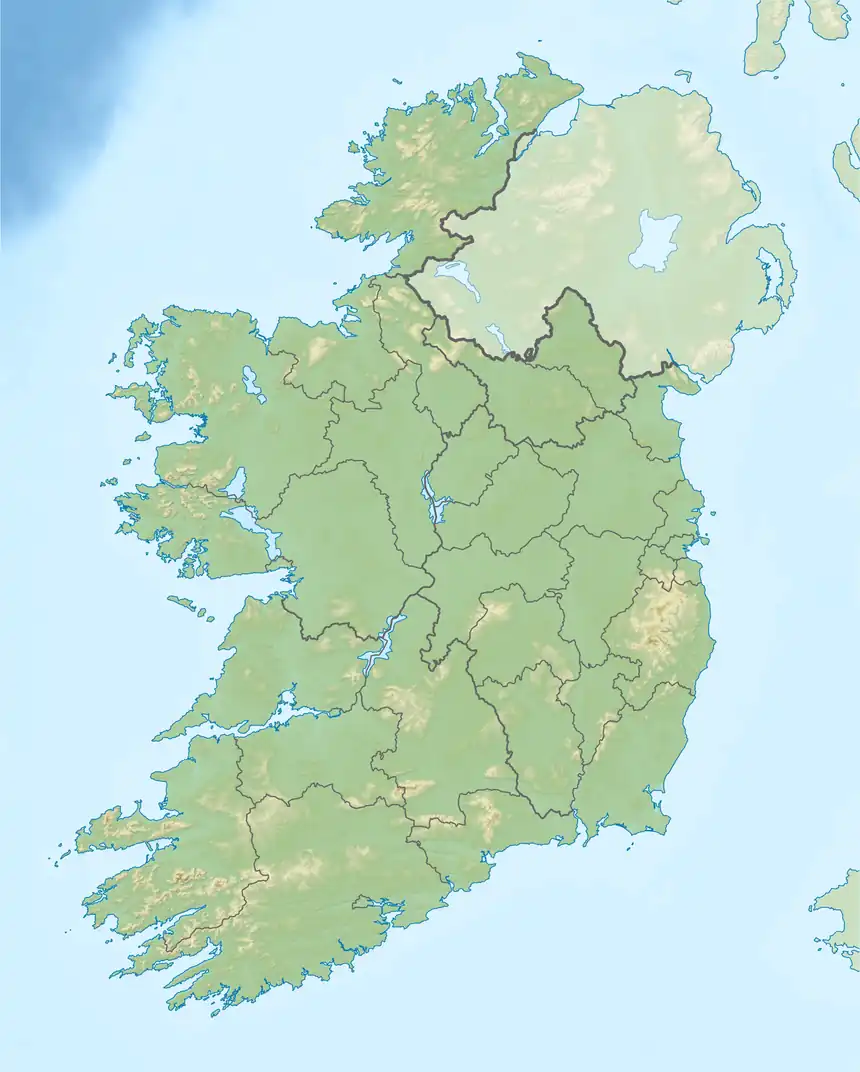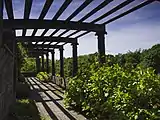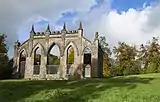| Heywood House Gardens | |
|---|---|
.jpg.webp) The oval pool in the Italian Garden | |
| Type | Garden |
| Location | Ballinakill, County Laois, Ireland |
| Coordinates | 52°53′03″N 7°18′03″W / 52.8843°N 7.3008°W |
| Built | 1906-1912 |
| Architect | Edwin Lutyens |
| Architectural style(s) | Italianate |
| Governing body | Office of Public Works |
 Location of Heywood House Gardens in Ireland | |
Heywood House Gardens, generally Heywood Gardens, form the grounds of a now-vanished house in County Laois, Ireland. The estate was developed in the late 18th century by Michael Frederick Trench, a politician, landowner and architect. He built a substantial house and laid out an extensive park, under the direction of James Gandon. In the early 20th century, Heywood was owned by Sir Hutcheson Poë who commissioned Edwin Lutyens to develop the gardens immediately surrounding the house. Lutyens engaged his long-time collaborator Gertrude Jekyll to undertake the planting. The house was demolished after a fire in 1950 and the gardens are now in the care of the Office of Public Works.
History and architecture
Michael Frederick Trench built Heywood House and developed the surrounding estate in conjunction with James Gandon.[1] The resulting parkland was considered by contemporaries to be one of the finest 18th century Romantic landscapes in Ireland.[2] The estate descended by marriage to the Poë family in the 19th century, when Colonel Hutcheson Poë married Mary Adelaide Compton Domvile in 1886.[3] In 1906 Poë determined on the development of a new garden immediately adjacent to the house.[4] The recommendation for Edwin Lutyens came from the colonial administrator Henry McMahon, who knew Lutyens personally.[5] By this date Lutyens had established himself as one of England's leading architects of country houses and gardens. In his study of English domestic buildings, Das englische Haus, published in 1904, Hermann Muthesius had written of him, "He is a young man who has come increasingly to the forefront of domestic architects and who may soon become the accepted leader among English builders of houses".[6] The site Lutyens was required to develop was unpromising; Heywood was set high on an elevated embankment with little space on the garden front between the house and an "enormous cliff-like buttress" which separated the house from the parkland.[7] Lutyens responded with the creation of a terrace linking a series of small garden rooms and leading to a circular Italian garden at the western end. The garden contains an oval pool, surrounded by turtles and with a fountain at its centre.[7] Gertrude Jekyll undertook the planting.[8] Poë was reputed to have spent £250,000 on the redevelopment of the house and estate.[3] Christopher Hussey, in his official biography The Life of Sir Edwin Lutyens, records that the Heywood scheme, ‘though architecturally superb, proved very much more costly than the client had contemplated".[lower-alpha 1][5]
Following Poë's death in 1934 the house was left empty until it was purchased in 1941 by the Salesian Brothers for the establishment of a seminary. During their tenure, the house was almost destroyed in a fire in 1951. It was subsequently demolished.[3] The seminary moved to a new site and the gardens passed into the care of the Office of Public Works.[11]
Gallery
 The summerhouse in the Italian Garden
The summerhouse in the Italian Garden The Pergola
The Pergola The Gothic Summerhouse
The Gothic Summerhouse The Sham Castle
The Sham Castle The Obelisk
The Obelisk
Notes
- ↑ Lutyens did not find Sir Hutchenson an easy client, his frustrations were expressed in a series of letters to his wife: "Colonel Poë has a wooden leg and he sits on a chair and watches the men lay stones and finds endless fault. I couldn't stand it."(7 February 1910);[9] "The gardens promise well, but he is so cross to his workmen, to me and to all under him".(30 August 1912)[10]
References
- ↑ "Michael Frederick Trench". www.dia.ie. Dictionary of Irish Architects. Retrieved 15 January 2022.
- ↑ "Heywood Gardens". Laois County Council. Retrieved 15 January 2022.
- 1 2 3 "History of the school". Heywood Community School. 28 February 2015.
- ↑ Amery, Richardson & Stamp 1981, p. 194.
- 1 2 Hussey 1989, p. 260.
- ↑ Muthesius 1979, p. 55.
- 1 2 Brown 1982, pp. 86–89.
- ↑ "Heywood Gardens, Heywood Demesne, Laois". National Inventory of Architectural Heritage. Retrieved 15 January 2022.
- ↑ Percy & Ridley 1985, p. 195.
- ↑ Percy & Ridley 1985, p. 259.
- ↑ "Heywood Gardens". heritageireland.ie. Heritage Ireland. Retrieved 15 January 2022.
Sources
- Amery, Colin; Richardson, Margaret; Stamp, Gavin (1981). Lutyens: The Work of the English Architect Sir Edwin Lutyens. London: Arts Council of Great Britain. ISBN 978-0-728-70303-2.
- Brown, Jane (1982). Gardens of a Golden Afternoon - The Story of a Partnership: Edwin Lutyens and Gertrude Jekyll. London: Penguin Books. ISBN 978-0-140-08021-6. OCLC 958950074.
- Hussey, Christopher (1989) [1950]. The Life of Sir Edwin Lutyens. Woodbridge: Antique Collectors Club. ISBN 978-0-907-46259-0.
- Lutyens, Edwin (1985). Clayre Percy; Jane Ridley (eds.). The Letters of Edwin Lutyens to his wife Lady Emily. London: Collins. ISBN 978-0-002-17063-5. OCLC 905461764.
- Muthesius, H. (1979) [1904]. The English House (Single volume ed.). Frogmore: Granada Publishing. ISBN 978-0-258-97101-7.